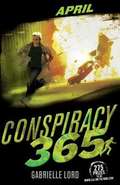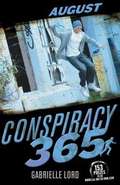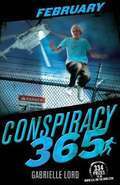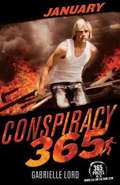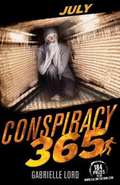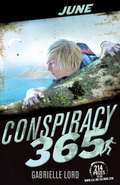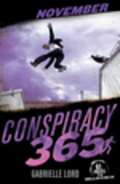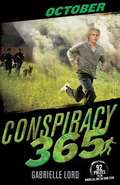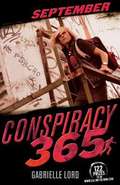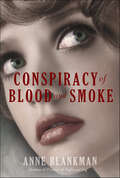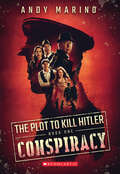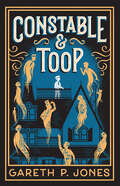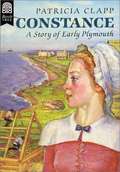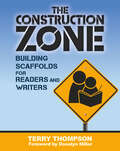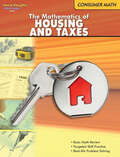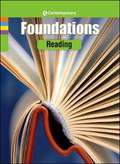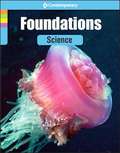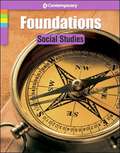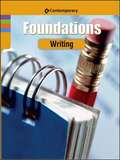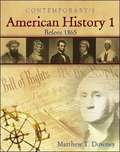- Table View
- List View
Conspiracy 365: April
by Gabrielle LordOn New Year's Eve, Callum Ormond is chased down the street by a crazed man with a deadly warning: They killed your father. They'll kill you. You must survive the next 365 days! Stranded in the middle of nowhere, terrified and alone, Cal is on the run. Somehow he must make sense of his father's mysterious drawings and solve a family secret from the past: the Ormond Singularity. But first he has to dodge the police and thugs who are closing in on him, and save his sister's life. He has 275 days. His world is falling apart...
Conspiracy 365: August
by Gabrielle LordOn New Year's Eve, Callum Ormond is chased down the street by a crazed man with a deadly warning: They killed your father. They'll kill you. You must survive the next 365 days. Cal is fighting for his sister's life. But nobody believes the 'psycho kid' and he's running out of people he can trust. He doesn't even know which of his enemies he's facing. How many hard-won treasures will he have to relinquish in return for his sister's safety?
Conspiracy 365: February
by Gabrielle LordOn New Year's Eve, Callum Ormond is chased down the street by a crazed man with a deadly warning: They killed your father. They'll kill you. You must survive the next 365 days! Now he's on the run. The people who killed his father want him dead, and the police are chasing him for a crime he didn't commit. A month has gone by and he's still no nearer to solving the Ormond Riddle, the family secret that has turned his life into a nightmare. Can he trust the mysterious Winter Frey, or will she lead him further into danger? He has 334 days. The clock is ticking...
Conspiracy 365: January
by Gabrielle LordOn New Year's Eve, Cal is chased down the street by a crazed man with a deadly warning: They killed your father. They'll kill you. You must survive the next 365 days! Forced into a life on the run, Cal finds himself hunted by ruthless criminals and the police. Somehow he must uncover the truth about his father's mysterious death and solve the Ormond Singularity, a secret from the past, before the year is up. But who can he turn to when the whole world seems to want him dead? The clock is ticking. Any second could be his last. Callum Ormond has been warned. He has 365 days. The countdown has begun ...
Conspiracy 365: July
by Gabrielle LordOn New Year's Eve, Callum Ormond is chased down the street by a crazed man with a deadly warning: They killed your father. They'll kill you. You must survive the next 365 days. Cal is running out of places to hide. Everywhere he goes, someone seems to be behind him, tracking his every move. They don't care who they hurt to get to him. As his sixteenth birthday approaches, the threat to him and his family increases. Nobody is safe while the secret of the Ormond Singularity remains unsolved. And Cal's enemies will do anything to make sure he doesn't see his sixteenth ... He has 184 days. He can't hide for ever ...
Conspiracy 365: June
by Gabrielle LordOn New Year's Eve, Callum Ormond is chased down the street by a crazed man with a deadly warning: They killed your father. They'll kill you. You must survive the next 365 days. Somebody wants Cal out of the way - for good. He's been living on the run for six months, hunted by criminals and the police as he tries to solve a sinister family secret from the past. He's been mauled by a lion, attacked by sharks and used as target practice on a firing range, but things are about to turn more dangerous yet. He has 205 days. Over half the year to go ...
Conspiracy 365: November
by Gabrielle LordOn New Year's Eve, Callum Ormond is chased down the street by a crazed man with a deadly warning: They killed your father. They'll kill you. You must survive the next 365 days! Pursued by helicopters, hunted across rooftops, Cal knows it's time to leave the country and solve the final part of the Ormond Riddle. But when he encounters an alarmingly familiar face, his recurring nightmare takes a jolt into reality. And it appears that the answer lies with a dying man ...
Conspiracy 365: October
by Gabrielle LordOn New Year's Eve, Callum Ormond is chased down the street by a crazed man with a deadly warning: They killed your father. They'll kill you. You must survive the next 365 days. Cal's beginning to understand only too well the meaning of the word 'deadline' as he struggles to stay alive. His enemies have united and the search for him is trebled. How much longer can he evade the assassins and cops trailing him, as well as trying to solve the legendary Ormond Riddle? Will the secret be lost for ever?
Conspiracy 365: September
by Gabrielle LordOn New Year's Eve, Callum Ormond is chased down the street by a crazed man with a deadly warning: They killed your father. They'll kill you. You must survive the next 365 days. Cal feels like a failure - it seems as if he's fighting everyone and getting nowhere. He needs his friends like never before. Nobody knows the answer to the riddle, but Cal begins to understand that the mystery may be far bigger than anyone realises. He can't give up now, no matter what the cost.
Conspiracy of Blood and Smoke
by Anne BlankmanAcclaimed author Anne Blankman returns to the shadowy and dangerous world of 1930s Germany in this thrilling sequel to Prisoner of Night and Fog, perfect for fans of Code Name Verity.The girl known as Gretchen Whitestone has a secret: She used to be part of Adolf Hitler's inner circle. More than a year after she made an enemy of her old family friend and fled Munich, she lives in England, posing as an ordinary German immigrant, and is preparing to graduate from high school. Her love, Daniel, is a reporter in town. For the first time in her life, Gretchen is content.But then Daniel gets a telegram that sends him back to Germany, and Gretchen's world turns upside down. When she receives word that Daniel is wanted for murder, she has to face the danger she thought she'd escaped—and return to her homeland. Gretchen must do everything she can to avoid capture, even though saving Daniel will mean consorting with her former friends, the Nazi elite. And as they work to clear Daniel's name, Gretchen and Daniel discover a deadly conspiracy stretching from the slums of Berlin to the Reichstag itself. Can they dig up the explosive truth and get out in time—or will Hitler discover them first?
Conspiracy: Conspiracy (The Plot to Kill Hitler #1)
by Andy MarinoBased on the real-life scheme to take down one of history's greatest monsters, this heart-pounding trilogy puts two courageous kids at the center of the plot to kill Adolf Hitler.Berlin, November 1943. With bombing raids commencing, the city is blanketed by explosions.Siblings Gerta and Max Hoffmann live a surprisingly carefree childhood amid the raids. Berlin is a city going about its business, even as it's attacked almost nightly.But one night, the air raid sirens wail, and the Hoffmanns' neighborhood is hit. A mortally wounded man comes to their door, begging to be let in. He asks for Karl Hoffmann, their father. Gerta and Max watch as Karl tries in vain to save the man's life.Before he dies, the stranger gives their father a bloodstained packet of documents, along with a message: "For the sake of humanity, the Führer must die. Finish it, Karl!"Based on real events, this is the story of two children swept up in a fight for the soul of Germany -- and the world.
Constable & Toop
by Gareth P. JonesSomething mysterious and terrible is happening throughout Victorian London: Ghosts are disappearing. When this reaches the attention of the Ghost Bureau, the diligent but clueless Mr. Lapsewood, a paranormal paper-pusher, is sent to investigate, and what he discovers is grave. The Black Rot has arrived—a voracious spiritual infestation whereby empty haunted houses suck in unsuspecting ghosts and imprison them. Lapsewood’s investigation weaves through the plotlines of several other memorable characters—both living and dead—including an undertaker’s son who can see ghosts, a serial throat-slasher reminiscent of Jack the Ripper, an evangelical exorcist, and many more. The living and dead must work together if they hope to destroy the Black Rot—before it destroys both the ghost and human worlds. This highly atmospheric and bitingly funny ghost story by successful British author Gareth P. Jones will delight fans of Eva Ibbotson and Neil Gaiman.
Constance: A Story of Early Plymouth
by Patricia C. ClappThe Indians started some sort of rhythmic chanting, with a clapping of their hands to accent it, and I sat a little apart at, one of the fires listening. It was a strange sound that somehow sent my blood pulsing more quickly and made me wish I could stand up and dance round and round the fire, but this I knew would not be fitting. Of a sudden I was aware of someone beside me, and turning, saw Ted Leister easing himself down to the ground. I thought it best to say nothing of the disagreement he and t'other Ted had, so I spoke of the singing. "It nigh makes me giddy," I said. "'Tis not at all like English singing." "If it makes you giddy, lie back and close your eyes," Ted Leister told me. "'Twill soon pass." I did as he suggested, and I could feel the very earth under me throbbing from the beat and beat and beat of the voices and hands. My eyes were closed, but the dizziness got no better and I moved to sit up when I felt Ted's hand push me gently back again, and then he kissed me.
Construction Zone: Building Scaffolds for Readers and Writers
by Terry ThompsonInstructional scaffolding is an essential part of teaching literacy. But what is scaffolding exactly? What does it look like in a classroom, and how can we improve the ways we use it? Despite its prominence in the repertoire of teaching strategies, scaffolding remains a vague concept for many teachers. ' In essence, scaffolding is the idea of supporting students as they build independence. In The Construction Zone: Building Scaffolding for Readers and Writers, Terry Thompson identifies four critical processes to deepen your understanding and improve your practice of instructional scaffolding: ·' ' ' ' ' ' ' ' Finding and maintaining a specific focus ·' ' ' ' ' ' ' ' Practicing flexibility in planning and delivering instruction ·' ' ' ' ' ' ' ' Giving constructive feedback in response to student efforts ·' ' ' ' ' ' ' ' Monitoring to ensure that students are working at optimal levels of responsibility Thompson' encourages teachers to enhance their use of the traditional gradual release process through five actionable steps: show, share, support, sustain, and survey, and in doing so provides procedures and techniques to help them establish and maintain strong scaffolds throughout the instructional day. The Construction Zone is written from the teacher's perspective and urges educators to fully embrace their role in the scaffolding process while staying mindful of the effect it has on students. ' Taking a student from dependence upon the teacher to independent learning is what teaching is all about, and instructional scaffolding is key to accomplishing this goal. Regardless of where you are in your understanding of instructional scaffolding, The Construction Zone will raise your level of awareness around your instructional practices and the ways you scaffold students to independence.' '
Consumer Math
by Larry D. Lemon Larry L. HallPrepare your students for making financial decisions with instruction about credit card charges, taxes, interest on loans and savings, personal banking, and costs of transportation, food, clothing, utilities, insurance, and filling out income tax forms. Being a good steward of the Lord's money is the primary emphasis. The student text presents concepts with numerous examples and step-by-step explanations. Each section contains five cumulative review problems, and each chapter contains a chapter review.
Consumer Math: The Mathematics of Housing and Taxes (Consumer Math Ser.)
by Steck-VaughnThis very practical series will help adolescents and adults alike to understand mathematics as it relates to their everyday lives. Each book covers basic math concepts and skills before exploring the more specific topics. Clear explanations are followed by ample practice. Each section also has a pretest, a section review, and a posttest.
Contemporary Foundations: Reading
by McGraw-HillContemporary's Foundations series helps students improve their basic skills. Each book provides skill instruction, offers interesting passages to study, and furnishes opportunities for practice. Foundations provides meaningful contexts for learning, using language which is easy to understand. About Foundations: Reading, Revised Edition: Foundations: Reading will help students improve their reading ability, as well as their writing and thinking skills. Foundations: Reading is divided into four units: Practical Reading: ''survival'' reading that you do everyday. Practical reading includes instructions, advertisements, and explanations. Reading Nonfiction: writing based on facts. Nonfiction includes newspaper and magazine articles, books about real people and real events, and encyclopedia articles. Reading Poetry: verse that captures a person's feelings. Learning to recognize form, rhythm, rhyme, and images will help you read and appreciate poetry. Reading Short Fiction: stories created from an author's imagination. Characters, setting, plot, and theme are important elements in every story. These special features in Foundations: Reading will help students practice language skills: Writing Workshops: detailed instructions that will guide the student through the four-step writing process: prewriting, drafting, revising, and editing Language Tips: explanations, pronunciations, study hints, and background information that will help the student understand what he or she is reading Test Skills: a reminder that this skill is often tested on standardized tests Posttest: a test, evaluation chart, and answer key, to gauge the mastery of each skill. Revised Edition Features: New language tips, Updated content, including revised passages, updated graphs and images, More exercises. About the Series: In Foundations: Reading, students will read practical information, nonfiction, poetry, and short stories. They will learn to find the main point and the details; identify fact, opinion, and bias; make inferences; read photographs and cartoons; and understand rhythm, rhyme, plot, and theme. Writing Workshops, Language Tips, and prereading questions are designed to improve reading, writing, and thinking skills. In Foundations: Writing, students will practice the four steps to writing an essay: prewriting, drafting, revising, and editing. They will read and write five kinds of essays: descriptive essays, personal narratives, how-to essays, essays of example, and comparison-and-contrast essays. A language-skills workbook provides grammar, punctuation, and sentence structure practice. In Your Journal, With a Partner, and Language Tips will help students become better writers, and better readers and thinkers as well. In Foundations: Science, students will learn about the human body, plant biology, physics, chemistry, and Earth science. They will practice putting events in order; reading diagrams, charts, and graphs; using the scientific method; and making comparisons and contrasts. Try It yourself! activities will guide students through simple experiments so they will have a better understanding of what they have been reading about. Writing Workshops and Language Tips will help students use their reading and writing skills to think about science topics. In Foundations: Social Studies, students will learn about world history, U.S. history, civics and government, geography, and economics. They will summarize, make predictions, infer the main idea of cartoons, find information on maps, and read various kinds of graphs. Background Information, Language Tips, and Writing Workshops will let students use what they already know as they read and write about social studies topics. The revised edition includes a new World History chapter. In Foundations: Math, students will practice using whole numbers, money, decimals, fractions, ratios, and percents. Exercises will help students review the addition, subtraction, multiplication, and division facts; round numbers; estimate answers; and solve word problems. Math Notes, On their Calculator, and Language ...
Contemporary Foundations: Science
by Wright Group/McGraw-HillContemporary's Foundations series helps students improve their basic skills. Each book provides skill instruction, offers interesting passages to study, and furnishes opportunities for practice.Foundations provides meaningful contexts for learning, using language which is easy to understand. About Foundations: Science, Revised Edition : In Foundations: Science, students will learn about the human body, plant biology, physics, chemistry, and Earth science. They will practice putting events in order; reading diagrams, charts, and graphs; using the scientific method; and making comparisons and contrasts. Try It yourself! activities will guide students through simple experiments so they will have a better understanding of what they have been reading about.Writing Workshops and Language Tips will help students use their reading and writing skills to think about science topics. About the Series: In Foundations: Reading, students will read practical information, nonfiction, poetry, and short stories. They will learn to find the main point and the details; identify fact, opinion, and bias; make inferences; read photographs and cartoons; and understand rhythm, rhyme, plot, and theme. Writing Workshops, Language Tips, and prereading questions are designed to improve reading, writing, and thinking skills. In Foundations: Writing, students will practice the four steps to writing an essay: prewriting, drafting, revising, and editing. They will read and write five kinds of essays: descriptive essays, personal narratives, how-to essays, essays of example, and comparison-and-contrast essays. A language-skills workbook provides grammar, punctuation, and sentence structure practice. In Your Journal, With a Partner, and Language Tips will help students become better writers, and better readers and thinkers as well. In Foundations: Science, students will learn about the human body, plant biology, physics, chemistry, and Earth science. They will practice putting events in order; reading diagrams, charts, and graphs; using the scientific method; and making comparisons and contrasts. Try It yourself! activities will guide students through simple experiments so they will have a better understanding of what they have been reading about. Writing Workshops and Language Tips will help students use their reading and writing skills to think about science topics. In Foundations: Social Studies, students will learn about world history, U.S. history, civics and government, geography, and economics. They will summarize, make predictions, infer the main idea of cartoons, find information on maps, and read various kinds of graphs. Background Information, Language Tips, and Writing Workshops will let students use what they already know as they read and write about social studies topics. The revised edition includes a new World History chapter. In Foundations: Math, students will practice using whole numbers, money, decimals, fractions, ratios, and percents. Exercises will help students review the addition, subtraction, multiplication, and division facts; round numbers; estimate answers; and solve word problems. Math Notes, On their Calculator, and Language Tips will help students improve math skills. The revised edition of Math is a major revision. The language has been updated to make the material even easier to follow than before.
Contemporary Foundations: Social Studies
by Wright Group/McGraw-HillContemporary'sFoundationsseries helps students improve their basic skills. Each book provides skill instruction, offers interesting passages to study, and furnishes opportunities for practice.Foundationsprovides meaningful contexts for learning, using language which is easy to understand. AboutFoundations: Social Studies, Revised Edition : In Foundations: Social Studies, students will learn about world history, U.S. history, civics and government, geography, and economics. They will summarize, make predictions, infer the main idea of cartoons, find information on maps, and read various kinds of graphs. Background Information,Language Tips, andWriting Workshops will let students use what they already know as they read and write about social studies topics. The revised edition includes a new World History chapter. About the Series: In Foundations: Reading, students will read practical information, nonfiction, poetry, and short stories. They will learn to find the main point and the details; identify fact, opinion, and bias; make inferences; read photographs and cartoons; and understand rhythm, rhyme, plot, and theme. Writing Workshops, Language Tips, and prereading questions are designed to improve reading, writing, and thinking skills. In Foundations: Writing, students will practice the four steps to writing an essay: prewriting, drafting, revising, and editing. They will read and write five kinds of essays: descriptive essays, personal narratives, how-to essays, essays of example, and comparison-and-contrast essays. A language-skills workbook provides grammar, punctuation, and sentence structure practice. In Your Journal, With a Partner, and Language Tipswill help students become better writers, and better readers and thinkers as well. In Foundations: Science, students will learn about the human body, plant biology, physics, chemistry, and Earth science. They will practice putting events in order; reading diagrams, charts, and graphs; using the scientific method; and making comparisons and contrasts. Try It yourself!activities will guide students through simple experiments so they will have a better understanding of what they have been reading about. Writing Workshops and Language Tips will help students use their reading and writing skills to think about science topics. In Foundations: Social Studies, students will learn about world history, U.S. history, civics and government, geography, and economics. They will summarize, make predictions, infer the main idea of cartoons, find information on maps, and read various kinds of graphs. Background Information, Language Tips, and Writing Workshops will let students use what they already know as they read and write about social studies topics. The revised edition includes a new World History chapter. In Foundations: Math, students will practice using whole numbers, money, decimals, fractions, ratios, and percents. Exercises will help students review the addition, subtraction, multiplication, and division facts; round numbers; estimate answers; and solve word problems. Math Notes, On their Calculator, and Language Tips will help students improve math skills. The revised edition of Math is a major revision. The language has been updated to make the material even easier to follow than before. Foundations series at a glance
Contemporary Foundations: Writing
by McGraw Hill Wright GroupContemporary'sFoundationsseries helps students improve their basic skills. Each book provides skill instruction, offers interesting passages to study, and furnishes opportunities for practice.Foundationsprovides meaningful contexts for learning, using language which is easy to understand. Foundations: Writingwill help students improve their writing skills, as well as their reading and thinking skills. Part I: Writing helps students practice the four stages of the writing process: Prewriting: planning and organizing Drafting: writing by following a plan Revising: evaluating and rewriting Editing: correcting grammar, mechanics, and usage Students will learn about five types of essays and practice writing each type: Descriptive Essay Personal Narrative How-To Essay Essay of Example Comparison-and-Contrast Essay Part II: Grammar focuses on language skills that writers need to understand. Grammar: nouns, pronouns, verbs, adjectives, and adverbs Punctuation: periods, question marks, exclamation marks, commas, and semicolons Sentence Structure: incomplete sentences, run-on sentences, and comma splices The following special features will help students practice their writing skills. In Your Journal: ideas to think about and write about on your own Language Tip: explanations, pronunciations, study hints, and background information that will help students understand what they read Test Skills: a reminder that this skill is often tested on standardized tests With a Partner: reading, writing, and thinking activities to do with a classmate, family member, or friend Posttest: a test, evaluation chart, and answer key to guage skill mastery Revised Edition Features: New language tips Updated content, including revised passages, updated graphs and images More exercises About the Series: In Foundations: Reading, students will read practical information, nonfiction, poetry, and short stories. They will learn to find the main point and the details; identify fact, opinion, and bias; make inferences; read photographs and cartoons; and understand rhythm, rhyme, plot, and theme. Writing Workshops, Language Tips, and prereading questions are designed to improve reading, writing, and thinking skills. In Foundations: Writing, students will practice the four steps to writing an essay: prewriting, drafting, revising, and editing. They will read and write five kinds of essays: descriptive essays, personal narratives, how-to essays, essays of example, and comparison-and-contrast essays. A language-skills workbook provides grammar, punctuation, and sentence structure practice. In Your Journal, With a Partner, and Language Tipswill help students become better writers, and better readers and thinkers as well. In Foundations: Science, students will learn about the human body, plant biology, physics, chemistry, and Earth science. They will practice putting events in order; reading diagrams, charts, and graphs; using the scientific method; and making comparisons and contrasts. Try It yourself!activities will guide students through simple experiments so they will have a better understanding of what they have been reading about. Writing Workshops and Language Tips will help students use their reading and writing skills to think about science topics. In Foundations: Social Studies, students will learn about world history, U.S. history, civics and government, geography, and economics. They will summarize, make predictions, infer the main idea of cartoons, find information on maps, and read various kinds of graphs. Background Information, Language Tips, and Writing Workshops will let students use what they already know as they read and write about social studies topics. The revised edition includes a new World History chapter. In Foundations: Math, students will practice using whole numbers, money, decimals, fractions, ratios, and percents. Exercises will help students review the addition, subtraction, multiplication, and division facts; round numbers; estimate answers; and solve word problems. Math Notes, On their Calculator, and Language Ti...
Contemporary World Studies: People, Places, and Societies, Guided Reading Workbook
by Houghton Mifflin HarcourtNIMAC-sourced textbook
Contemporary's American History 1: Before 1865 [Grade 6-12]
by Matthew T. DowneyAmerican History 1: before 1865covers America's story from its beginning through the end of the Civil War. 20 chapters in provide information about American history from economic, geographic, political, religious, technological, social, and cultural perspectives. Student Edition: Engaging four-color design Unit openers with timelines and discussion questions Pre-reading strategies and introduction activities Reading and vocabulary support Small-group activities Writing activities Primary source documents Chapter summaries with review questions End of chapter skill builder
Contemporary's American History 1: Before 1865 [Grade 6-12]
by Matthew T. DowneyAmerican History 1: before 1865covers America's story from its beginning through the end of the Civil War. 20 chapters in provide information about American history from economic, geographic, political, religious, technological, social, and cultural perspectives. Student Edition: Engaging four-color design Unit openers with timelines and discussion questions Pre-reading strategies and introduction activities Reading and vocabulary support Small-group activities Writing activities Primary source documents Chapter summaries with review questions End of chapter skill builder
